Numizmatyka - kolekcjoner monet. || Silver one-dollar coins - collector. [POL-ENG].
Kiedy dodawałem swój pierwszy post, nie wiedziałem, że najlepszą drogą jest przedstawienie się. Nie napisałem „mój pierwszy post na HIVE” (tamtym czasem STEEMIT). Bardzo słabo potrafiłem poruszać się po tym miejscu i nie miałem żadnego znajomego, który by mnie wtedy poprowadził. Trzeba było radzić sobie samemu. Do dzisiaj, wielu rzeczy jeszcze tutaj nie ogarniam, ale teraz przynajmniej wiem, kogo mogę zapytać i wiem, że otrzymam pomoc.
Z jednej strony trochę żałuję, że zabrakło mojego powitalnego wpisu, bo teraz po latach już wiem, że jest to jakby pozycja obowiązkowa. Jednakże, z drugiej strony nie ma co się smucić nad rozlanym mlekiem i w nie wpatrywać. Zawsze, z każdej sytuacji staram się wyciągnąć i dostrzec pozytywny element. Tutaj tym pozytywem jest to, że mogę się przedstawiać za każdym razem, kiedy opisuje swoje zainteresowania, o których wcześniej jeszcze nie pisałem. Wiem, że to nie to samo, no ale zawsze coś. Jednym z moich hobby, które pamiętam od dziecka, a o którym jeszcze nic nigdy nie napisałem jest zbieranie monet i banknotów. Jako dzieciak, jakieś 20 parę lat temu, zbierałem monety amerykańskie. Mam rodzinę w USA, więc otrzymywaliśmy co jakiś czas „paczkę od cioci z Ameryki”. Snułem wtedy marzenia, że za lat kilkanaście okaże się, że są to cenne – jeśli nie najcenniejsze – monety, jakie można tylko mieć. Później jako nastolatek zbierałem „stare monety” i monety okolicznościowe. Teraz, bliżej teraźniejszości dalej mi zostało hobby z dzieciństwa, jednakże dosyć sporo się pozmieniało. Jako dorosły człowiek, otoczony wszechobecną wiedzą z Internetu, jakiś czas temu sprawdziłem swoją kolekcję lat młodzieńczych i spotkało mnie spore rozczarowanie. Okazało się, że moje zbiory prócz wspomnień, nie mają żadnej realnej wartości… Najprawdopodobniej ciocia wiedziała od mamy, że mam hobby i zbieram monety, więc wrzucała do przysłanych par skarpet kilka centówek. Wkładała resztę wydaną jej w sklepie, żebym miał frajdę przy przeglądaniu prezentów. Co do monet okolicznościowych, ich wartość teraz jest zbliżona do wartości sprzed lat. Nakłady były w ogromnych ilościach, a monety powszechnie dostępne.
Smutek nie trwał zbyt długo, ponieważ wciąż mi towarzyszy uśmiech na ustach, kiedy myślę o cioci wrzucającej centówki do kartonowej paczki z myślą o siostrzeńcu. Lub kiedy przypominam sobie moją mamę i jej próby stawania na głowie, żeby mi znaleźć i podarować jakąś „ciekawą” monetę. Dzięki znajomości z panią sklepikarką z osiedlowego sklepiku miała dojście do tych „nietypowych”.
Zbierałem również banknot. Tych miałem znacznie mniej i moją kolekcję opierałem głównie na pieniądzach mojego taty, który mi je podarował. On sam, podróżował po świecie za pracą na chleb, żebyśmy z braćmi mieli co jeść. Tu i ówdzie zabierał, wymieniał się i kupował banknoty z różnych krajów. Prawdopodobnie po nim mam tą kolekcjonerską zajawkę.
Tak więc przełknąłem gorycz porażki i zacząłem zgłębiać temat, w bardziej świadomy i profesjonalny sposób. Dowiedziałem się, że moje hobby to numizmatyka.
Słowo numizmatyka pochodzi od greckiego słowa nomisma i ma ona swoje początki w XIV w.
Do głównych zadań numizmatyki zalicza się:
- Kolekcjonowanie i klasyfikowanie monet
- Datowanie monet
- Ustalanie użytkowników danych monet
- Interpretowanie i wyjaśnianie faktów i procesów dziejowych
- Określanie dodatkowych funkcji monet
Po latach zbierania, trochę mi się tego uzbierało. Niektóre okazy mają wyłącznie wartość sentymentalną. Jak wcześniej wspomniałem. Są jednak w mojej kolekcji monety, które już są interesującą pozycją dla kolekcjonerów, a z roku na rok nabierają na wartości. Wiele monet kupiłem po okazyjnej cenie. Często, w momencie, kiedy zbieranie monet było mniej popularne. Jak w każdej dziedzinie życia, są osoby tzw. sezonowe, czyli zainteresowani chwilowo tematem, pod wpływem emocji lub jakiegoś impulsu dokonują zakupu. Po pewnym czasie – przeważnie szybciej niż później – zainteresowanie przechodzi i pozbywają się swoich zbiorów.
Ja do swojego hobby podchodzę w inny sposób. Jeśli ma to być inwestycja, to na pewno długoterminowa. Zbiory przekaże swoim dzieciom lub wnukom – zakładając, że będę miał jedne i/lub drugie. Być może oni coś na tym zarobią i będą dobrze wspominać dziadka 😉.
Historia trzech srebrnych jednodolarówek.
Zakup trzech poniższych jednodolarówek był całkowicie nieplanowany. Jakiś czas temu, czekając na spotkanie ze znajomym, kręciłem się wzdłuż jednej z Krakowskich ulic. Miałem dość sporo czasu w zapasie i dla zabicia nudy przeglądałem witryny sklepów. Nagle natknąłem się na sklep z wszelkiego typu różnościami. Wszedłem do środka. Wewnątrz było chyba wszystko. Obrazy mniejsze i większe, figurki drewniane i gipsowe, kolorowe kamienie, biżuteria, książki i masa innych bibelotów. Oglądając asortyment sklepu, wdałem się w rozmowę z właścicielem. Rozmawialiśmy luźno o przeróżnych sprawach. Okazał się bardzo sympatyczny, więc rozmawiało nam się dobrze. Temat rozmowy w pewnym momencie przeszedł na kolekcjonerstwo. Nagle wyciągnął na ladę czarne małe opakowanie i powiedział, że ma coś na sprzedaż. W środku znajdowały się trzy monety, które zostawił u niego jakiś czas temu starszy Pan, który długie lata zbierał monety. Po dokładnym oglądnięciu monet sprawdzeniu ich stanu, rocznika i oznaczeń menniczych oraz delikatnej negocjacji ceny niespodziewanie stałem się posiadaczem trzech srebrnych jednodolarówek.
ONE DOLLAR 1885
Dolar Morgana – amerykańska srebrna moneta obiegowa o nominale jednego dolara amerykańskiego.
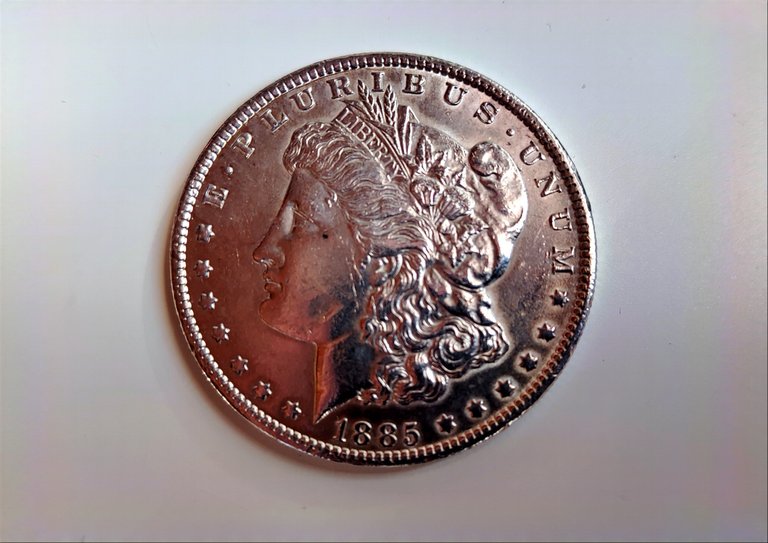

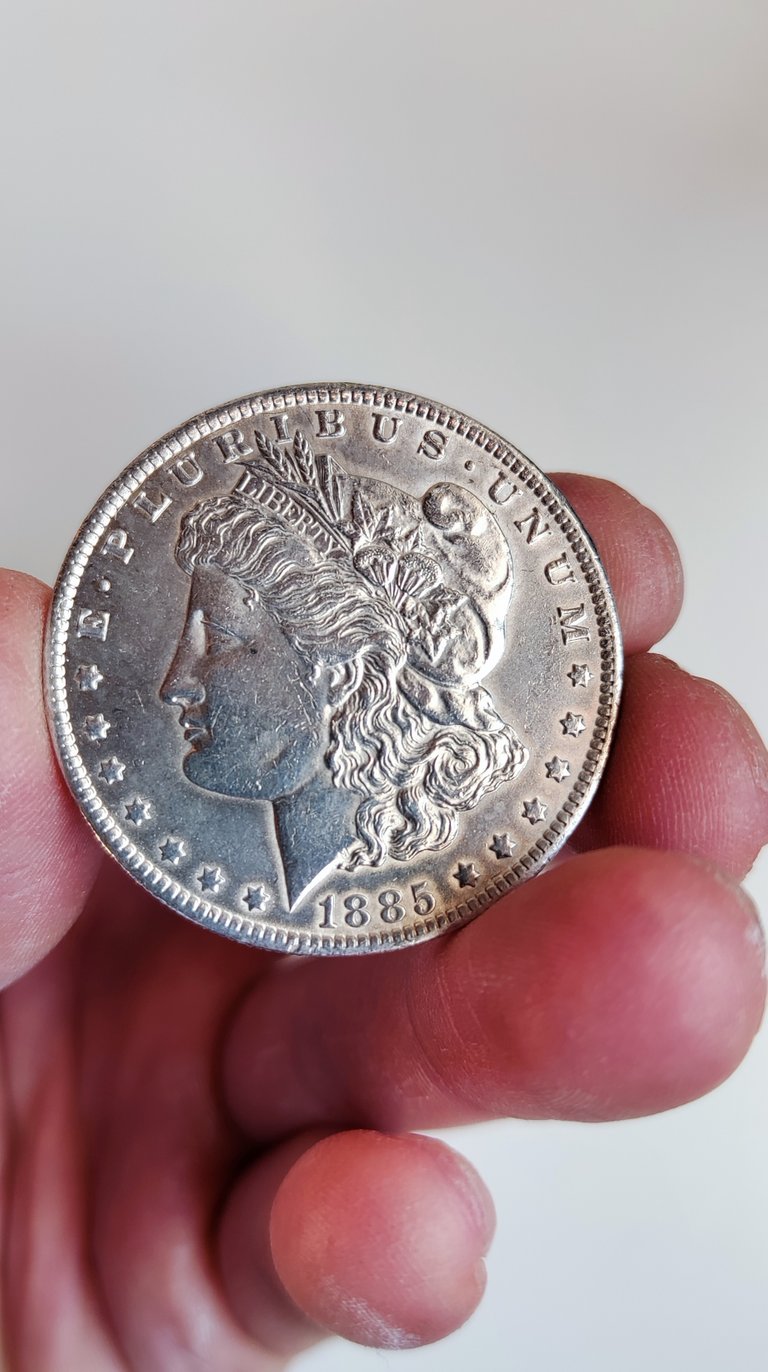


Dodałem te same zdjęcia z różnymi filtrami, aby lepiej można było zobaczyć wszystkie detale.
ONE DOLLAR 1921
Dolar Morgana – amerykańska srebrna moneta obiegowa o nominale jednego dolara amerykańskiego.
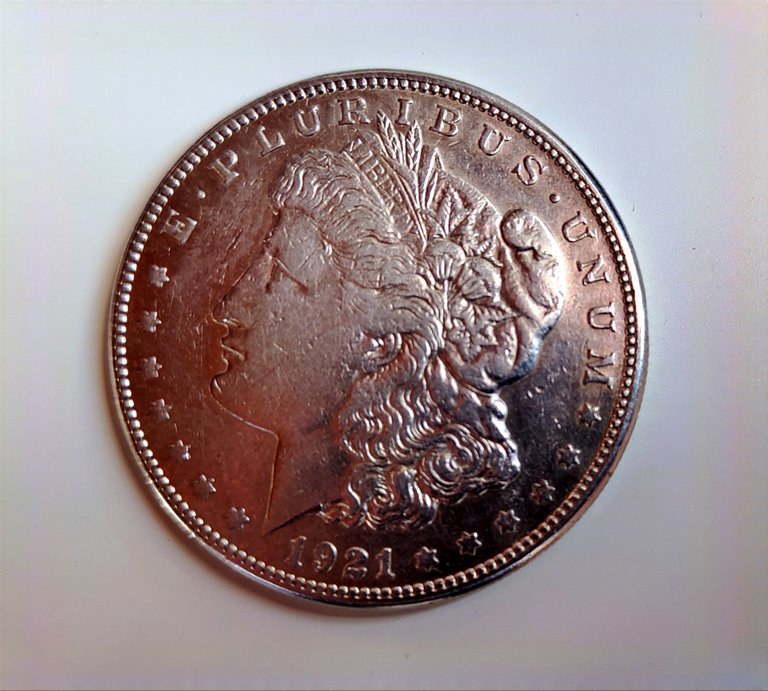



Informacje:
Państwo: Stany Zjednoczone
Emitent: Departament Skarbu Stanów Zjednoczonych
Mennica: U.S. Mint
Nominał: 1 dolar amerykański
Lata bicia: 1878–1904 i 1921
Masa: 26,73 g
Średnica: 38,1 mm
Krawędź: ząbkowana
Materiał: Ag 900 (srebro 90%, miedź 10%)
Mennica: Filadelfia, Nowy Orlean, Carson City, Denver, San Francisco
Litery oznaczające mennicę, w której wybito monety umieszczano pod wieńcem laurowym
Awers
Projekt: głowa personifikacji wolności
Projektant: George T. Morgan
Awers monety przedstawia profil personifikacji wolności we frygijskim nakryciu głowy z wieńcem z pszenicy i liści bawełny. Ponad głową legendę stanowi motto „E•PLURIBUS•UNUM” (łac. „Z wielu, jeden” ). Po lewej i prawej stronie profilu znajduje się łącznie 13 gwiazd. Na dole monety znajduje się rok wybicia.
Źródło: wikipedia.
Rewers
Projekt: orzeł z rozpostartymi skrzydłami
Projektant: George T. Morgan
W centrum pola rewersu wybito orła z rozpostartymi skrzydłami, który w szponach trzyma gałązki oliwne i strzały. Pod orłem znajduje się wieniec laurowy. Nad głową orła, pomiędzy skrzydłami dewiza „In God We Trust” w staroangielskim kroju pisma. Wzdłuż otoku znajduje się legenda „★UNITED STATES OF AMERICA★ONE DOLLAR”
Źródło: wikipedia.
ONE DOLLAR 1925
Dolar Pokoju – amerykańska srebrna moneta obiegowa o nominale jednego dolara amerykańskiego, zaprojektowana w celu upamiętnienia zwycięskiego zakończenia I wojny światowej.


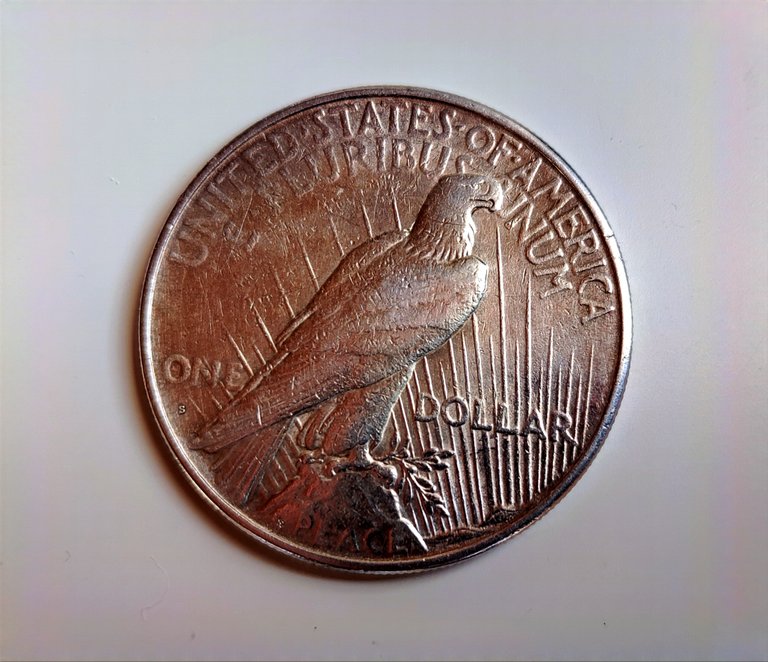
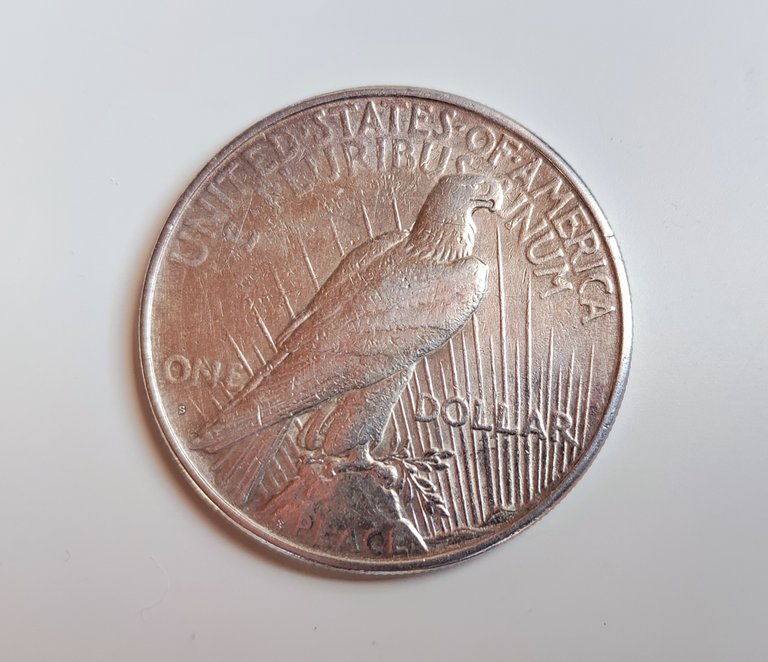
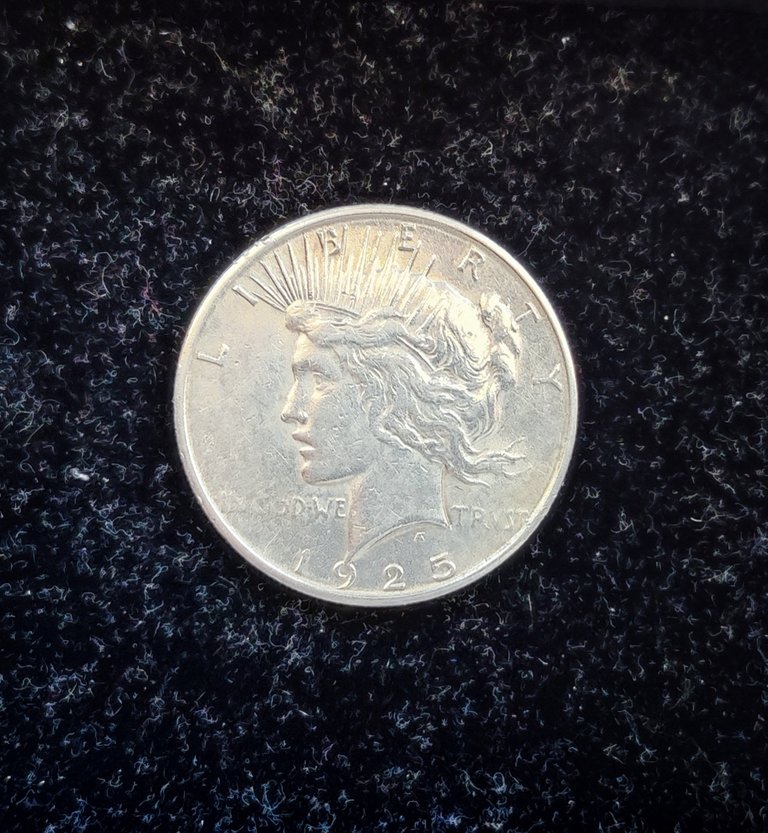

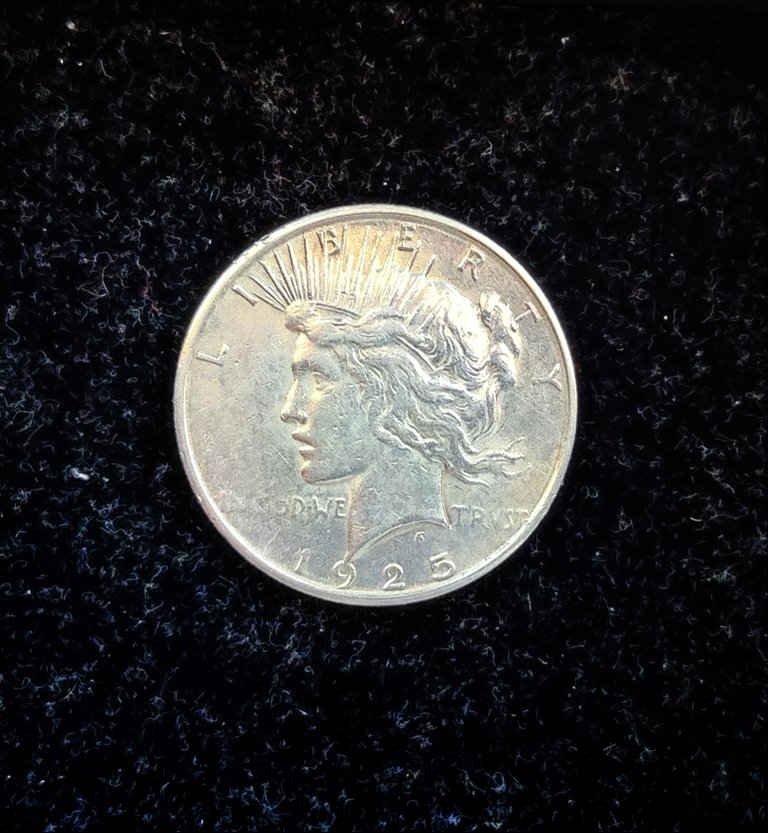
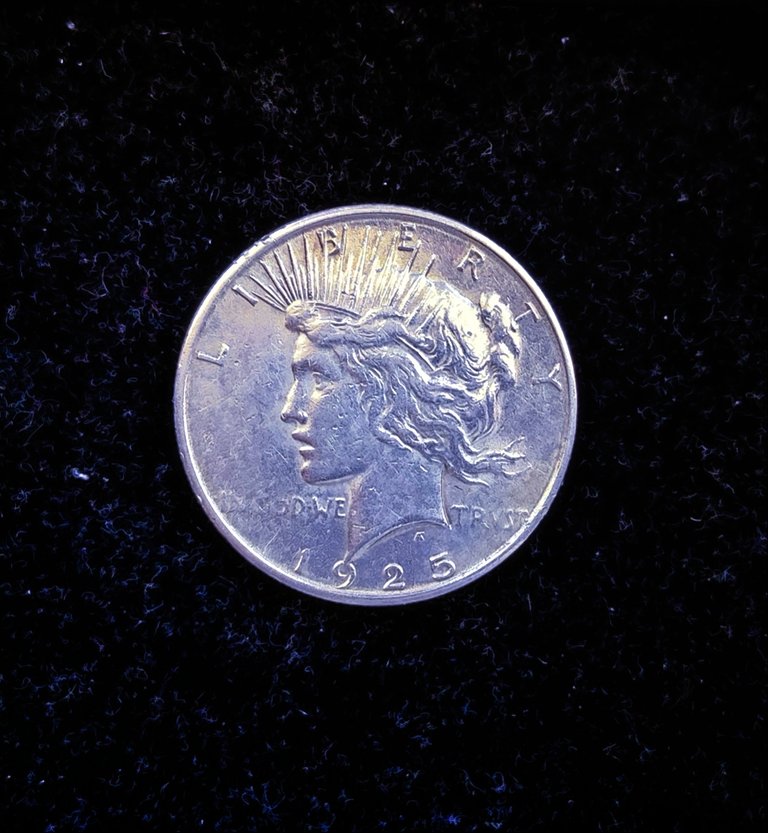
Zdjęcia z różnymi filtrami, aby lepiej widzieć detale.
Informacje:
Państwo: Stany Zjednoczone
Emitent: Departament Skarbu Stanów Zjednoczonych
Mennica: U.S. Mint
Nominał: 1 dolar amerykański
Lata bicia: 1921–1928, 1934–1935
Masa: 26,73 g
Średnica: 38,1 mm
Krawędź: ząbkowana
Materiał: Ag 900 (srebro 90%, miedź 10%)
Mennica: Filadelfia, Denver, San Francisco
Awers
Projekt: profil personifikacji wolności
Projektant: Anthony de Francisci
Przedstawienie personifikacji wolności miało nawiązywać do wyobrażenia wolności z rozpuszczonymi włosami na monecie Saint-Gaudens double eagle. Przy projektowaniu profilu wolności de Francisci inspirował się swoją żoną. Wzdłuż górnego otoku monety, częściowo zasłonięty koroną, napis „LIBERTY”. Profil wolności rozdziela dewizę zapisaną w formie „•IN•GOD•WE TRVST•”. Na dole monety, wzdłuż otoku rok wybicia. Pod szyją wolności znajduje się monogram projektanta „AF".
Źródło: wikipedia.
Rewers
Projekt: orzeł na szczycie góry z gałązką oliwną
Projektant: Anthony de Francisci/George T. Morgan
Pierwotny rewers, który nie został ostatecznie wybity, przedstawiał orła łamiącego miecz. Po protestach środowisk weteranów wizerunek rewersu został poprawiony. Ostateczna wersja przedstawia orła, który siedzi na górze z gałązką oliwną (symbol pokoju) i spogląda na wschodzące słońce i w kierunku Europy. Na górze, wzdłuż otoku wybita nazwa państwa „UNITED STATES OF AMERICA”, pod nim motto „E•PLURIBUS•UNUM” (łac. „Z wielu, jeden”). Sylwetka orła rozdziela nominał monety. Na skale widnieje napis „PEACE”. Na rewersie wybijany był także znak mennicy, pod słowem „ONE”, w promieniach słońca.
Źródło: wikipedia.
Inspiracją do tego wpisu była jedna ze ścian w @krolestwo, którą widziałem podczas zeszłorocznej imprezy HIVE.BLOG organizowanej przez @hallmann i @wadera.
Dziękuję za przeczytanie i życzę Wam miłego dnia.

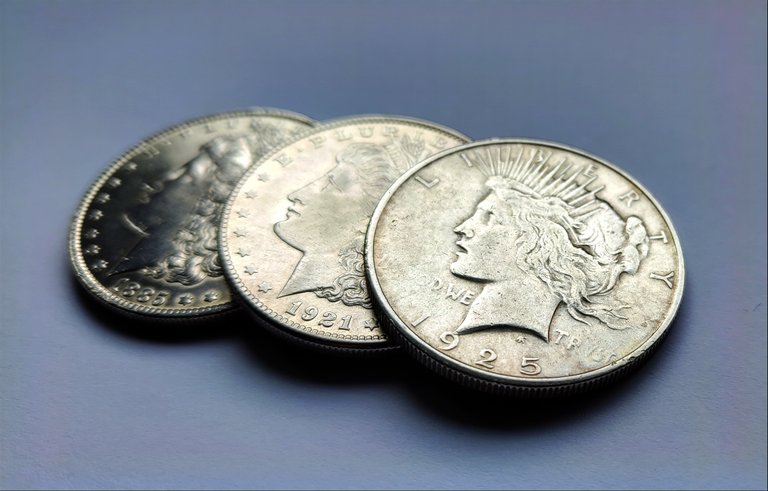

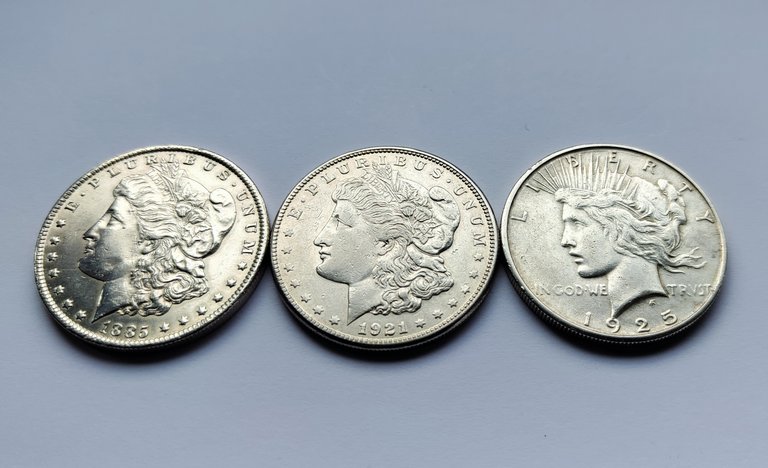


ENGLISH VERSION
When I added my first post, I didn't know that the best way was to introduce myself. I didn't write "my first post on HIVE" (that time STEEMIT). I was very poor at navigating the site and had no friend to guide me at the time. You had to manage on your own. To this day, I still don't grasp many things here, but now at least I know who I can ask and I know that I will get help.
On the one hand, I'm a little sorry that my welcome post was missing, because now, years later, I know that this is kind of a must-read item. However, on the other hand, there is no need to grieve over spilled milk and stare into it. Always, from every situation I try to draw and see the positive element. Here, that positive is that I can introduce myself whenever I describe my interests, which I have not yet written about before. I know it's not the same, but it's always something. One of my hobbies that I remember since I was a kid, and which I've never written anything about yet, is collecting coins and banknotes. As a kid, about 20 some years ago, I used to collect US coins. I have family in the U.S., so we used to get a "package from my aunt in America" from time to time. At the time, I dreamed that in a dozen years or so, these would turn out to be the most valuable - if not the most valuable - coins one could ever have. Later, as a teenager, I collected "old coins" and commemorative coins. Now, closer to the present I still have the hobby from my childhood, however, quite a lot has changed. As an adult, surrounded by ubiquitous knowledge from the Internet, some time ago I checked my collection of my teenage years and was met with quite a disappointment. It turned out that my collection, apart from memories, had no real value... Most likely, my aunt knew from my mother that I had a hobby and collected coins, so she put a few cents in the pairs of socks she sent me. She would put in the change she spent in the store so that I would have fun looking through the gifts. As for commemorative coins, their value now is close to that of years ago. Mintages of pieces were in huge quantities, and coins were widely available.
The sadness didn't last too long, because I still have a smile on my lips when I think of my aunt dropping cents into a cardboard package with my nephew in mind. Or when I recall my mother and her attempts to stand on her head to find and give me some "interesting" coin. Thanks to her acquaintance with a lady shopkeeper from a neighborhood store, she had access to these "unusual" ones.
I also collected a banknote. These I had much less of, and my collection was based mainly on my dad's money, who gave it to me. He himself, traveled the world for bread work so that my brothers and I would have something to eat. Here and there he took, exchanged and bought banknotes from different countries. I probably got this hobby from him.
So I swallowed the bitterness of defeat and started to explore the subject in a more conscious and professional way. I found out that my hobby is called numismatics.
The word numismatics is derived from the Greek word nomisma and has its origins in the 14th century.
The main tasks of numismatics include:
- Collecting and classifying coins
- Dating coins
- Determining the users of the coins in question
- Interpreting and explaining historical facts and processes
- Determining additional functions of coins
After years of collecting, I've collected a bit of it. Some specimens have only sentimental value. As I mentioned earlier. However, there are coins in my collection that are already an interesting item for collectors, and they are increasing in value every year. Many coins I bought at a bargain price. Often, at a time when coin collecting was less popular. As in any area of life, there are so-called seasonal people, that is, those interested in the subject temporarily, under the influence of emotion or some impulse make a purchase. After some time - usually sooner rather than later - the interest passes and they get rid of their collections.
I approach my hobby in a different way. If it is to be an investment, it is definitely a long-term one. I will pass the collection on to my children or grandchildren - assuming I have one and/or the other. Perhaps they will earn something from it and remember their grandfather well 😉 .
The story of three silver one-dollar coins.
The purchase of the following three one-dollar coins was completely unplanned. Some time ago, while waiting to meet a friend, I was hanging around along one of Krakow's streets. I had quite a bit of time in reserve and was browsing through storefronts to kill boredom. Suddenly, I came across a store with all kinds of miscellaneous items. I went inside. Inside there was probably everything. Paintings smaller and larger, wooden and plaster figurines, colorful stones, jewelry, books and a mass of other trinkets. While looking at the store's assortment, I got into a conversation with the owner. We talked loosely about all sorts of things. He turned out to be very friendly, so we had a good conversation. The topic of conversation at one point switched to collectibles. Suddenly he pulled out a small black package on the counter and said he had something for sale. Inside were three coins that had been left with him some time ago by an elderly gentleman who had collected coins for many years. After carefully examining the coins checking their condition, vintage and mint markings and gently negotiating the price, I unexpectedly became the owner of three silver one-dollar coins.
ONE DOLLAR 1885
Morgan dollar - American silver circulation coin with a denomination of one US dollar.





I added the same photos with different filters so you can better see all the details.
ONE DOLLAR 1921
Morgan dollar - American silver circulation coin with a denomination of one US dollar




Information:
Country: United States
Issuer: United States Department of the Treasury
Mint: U.S. Mint
Denomination: 1 U.S. dollar
Minting years: 1878-1904 and 1921
Weight: 26.73 g
Diameter: 38.1 mm
Edge: serrated
Material: Ag 900 (90% silver, 10% copper)
Mint: Philadelphia, New Orleans, Carson City, Denver, San Francisco
The letters denoting the mint where the coins were struck were placed under the laurel wreath
Obverse
Design: head of the personification of freedom
Designer: George T. Morgan
The obverse of the coin depicts the profile of the personification of freedom in a Phrygian headdress with a wreath of wheat and cotton leaves. Above the head the legend is the motto "E-PLURIBUS-UNUM" (Latin for "Out of many, one" ). To the left and right of the profile are a total of 13 stars. At the bottom of the coin is the year of minting..
Source: wikipedia.
Reverse
Design: eagle with outspread wings
Designer: George T. Morgan
In the center of the reverse field is struck an eagle with outspread wings, which holds olive branches and arrows in its talons. Below the eagle is a laurel wreath. Above the eagle's head, between the wings is the motto "In God We Trust" in Old English typeface. Along the rim is the legend "★UNITED STATES OF AMERICA★ONE DOLLAR ".
Source: wikipedia.
ONE DOLLAR 1925
The Peace Dollar - an American silver circulation coin with a denomination of one US dollar, designed to commemorate the victorious end of World War I.








Photos with different filters to see details better.
Information:
Country: United States
Issuer: United States Department of the Treasury
Mint: U.S. Mint
Denomination: 1 U.S. dollar
Minting years: 1921-1928, 1934-1935
Weight: 26.73 g
Diameter: 38.1 mm
Edge: serrated
Material: Ag 900 (90% silver, 10% copper)
Mint: Philadelphia, Denver, San Francisco
Obverse
Design: profile of the personification of freedom
Designer: Anthony de Francisci
The depiction of the personification of liberty was meant to refer to the image of liberty with loose hair on the Saint-Gaudens double eagle coin. In designing the profile of liberty, de Francisci was inspired by his wife. Along the top rim of the coin, partially obscured by a crown, is the inscription "LIBERTY." The profile of liberty splits the motto written in the form "-IN-GOD-WE TRVST-". At the bottom of the coin, along the rim, the year of minting. Under the neck of the liberty is the designer's monogram "AF"..
Source: wikipedia.
Reverse
Design: eagle on top of a mountain with an olive branch
Designer: Anthony de Francisci/George T. Morgan
The original reverse, which was not eventually minted, depicted an eagle breaking a sword. After protests from the veterans' community, the image of the reverse was revised. The final version depicts an eagle perched on a mountain with an olive branch (a symbol of peace) and looking at the rising sun and toward Europe. At the top, the name of the country "UNITED STATES OF AMERICA" is stamped along the rim, with the motto "E-PLURIBUS-UNUM" (Latin for "Out of many, one") below it. A silhouette of an eagle splits the coin's denomination. The rock bears the inscription "PEACE". The mintmark was also minted on the reverse, under the word "ONE", in sunlight..
Source: wikipedia.
The inspiration for this post came from one of the walls at @krolestwo that I saw at last year's event HIVE.BLOG organized by @hallmann and @wadera.
Thank you for reading and have a great day.





https://twitter.com/1269307561792151555/status/1630161647447810048
The rewards earned on this comment will go directly to the people( @polish.hive ) sharing the post on Twitter as long as they are registered with @poshtoken. Sign up at https://hiveposh.com.
You'll be happy when you find out the "real value" of those three Silver Dollars, in the "Very Near Future"...
I'd really like to know what you mean "very near furute" ;D
Since the Present is everlasting, all things happen in the Present, or as I like to write, the "Very Near Future" which is the closest we can get to the Future... The Present is so close to the Future, that the smallest fraction of Time, can not fit between the Two... If that's not very near, I don't know what is...
Thanks for sharing, absolutely some of my favorite coins! They were such pretty productions of art, you don't see that as much today sadly. Keep on stacking!
!CTP
Yes it is true these coins are beautiful. Thank you @thebighigg 🖐🏻
Your welcome!
!lol
lolztoken.com
But I forgot to mention it to him.
Credit: reddit
@peter.goki, I sent you an $LOLZ on behalf of @thebighigg
(5/8)
Those are my favorite US Silver Dollar coins! Nice presentation!
!invest_vote
Posted Using LeoFinance Beta
@silversaver888 denkt du hast ein Vote durch @investinthefutur verdient!
@silversaver888 thinks you have earned a vote of @investinthefutur !